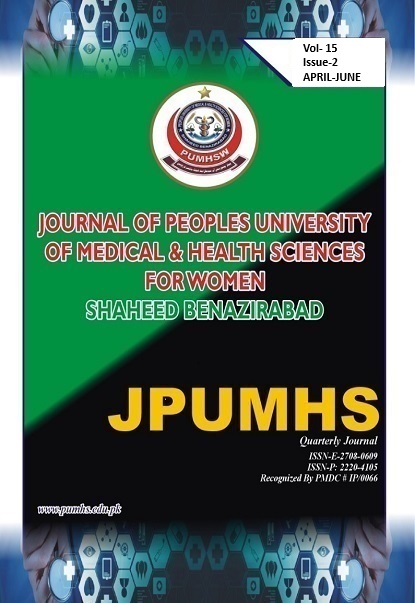DIAGNOSTIC YIELD FROM SYMPTOMATIC COLONOSCOPY: A CROSS SECTIONAL STUDY FROM GAJJU KHAN MEDICAL COLLEGE SWABI.
J Peop Univ Med Health Sci. 2025:15(2), 43-54. http://doi.org/10.46536/jpumhs/2025/15.02.622
Keywords:
GI Pathologies, Rectal Bleeding, Hemorrhoids, Diarrhea, Colonoscopy.Abstract
BACKGROUND: Colonoscopy is an essential diagnostic tool for detecting underlying lower gastrointestinal pathologies. Evaluating its diagnostic yield and its relationship with patient demographics and clinical indications can enhance its utility and improve patient care outcomes. OBJECTIVE: To evaluate the diagnostic yield of colonoscopy in patients presenting with lower gastrointestinal symptoms and to analyze its association with patient demographics, clinical indications, and underlying pathologies. METHODS: This retrospective study, conducted at Gastroenterology Department, Gajju Khan Medical College, Swabi, from September 2019 to September 2024. A total of 1119 adult patients presenting with lower gastrointestinal symptoms were enrolled. Data on demographics, clinical indications, and colonoscopy findings were collected through structured questionnaires and medical records. Data analysis was conducted using SPSS version 26 to calculate diagnostic yield and assess associations with age, gender, and clinical symptoms. RESULTS: Mean age of participants was 41±14 years, with 62% being male. The most common clinical indications were per rectal bleeding (42.1%), chronic diarrhea (17.2%), and abdominal pain (12.7%). The overall diagnostic yield of colonoscopy was 69%, with hemorrhoids (24.8%), rectal polyps (5.1%), and ulcerative colitis (4.9%) being the most frequent findings. Significant associations were observed between diagnostic yield and clinical symptoms (p=0.001). Hemorrhoids were more prevalent in males (p<0.001) and older age groups. CONCLUSION: Colonoscopy demonstrated a high diagnostic yield of 69% in patients with lower gastrointestinalbsymptoms. Patient demographics and clinical indications, particularly per rectal bleeding, were significantly associated with diagnostic outcomes, highlighting the importance of targeted diagnostic approaches to improve patient management.
Downloads
Downloads
Published
How to Cite
Issue
Section
License

This work is licensed under a Creative Commons Attribution-NoDerivatives 4.0 International License.




